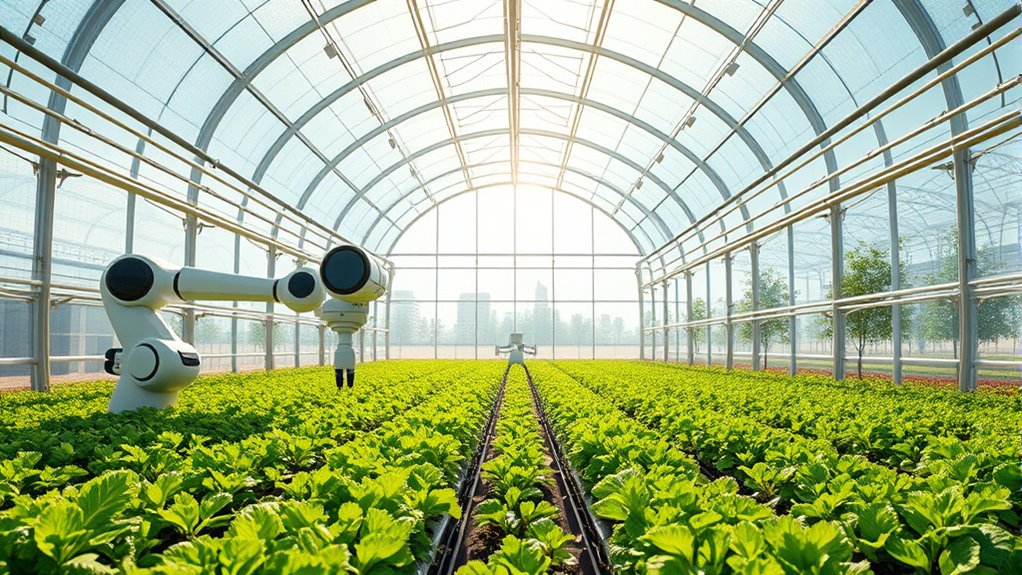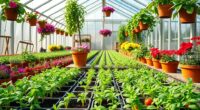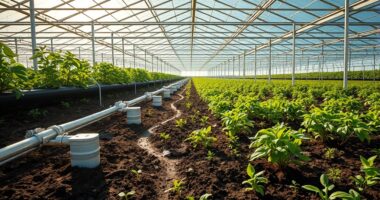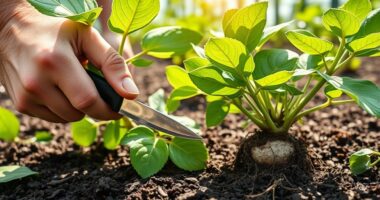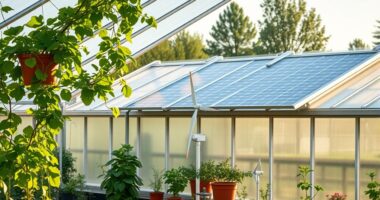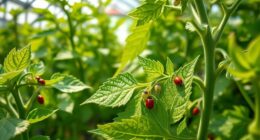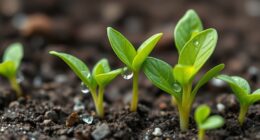Smart greenhouses are transforming agriculture by combining IoT sensors, AI analytics, and automation to optimize crop growth and resource use. They control temperature, humidity, light, and watering precisely, reducing waste and boosting yield. Sustainable practices like energy efficiency and water recycling make them environmentally friendly. While challenges like costs exist, ongoing innovations promise to make these systems more accessible, smarter, and resilient. To explore how this technology shapes the future of farming, keep exploring.
Key Takeaways
- IoT sensors and AI-driven analytics enable precise environmental control for optimized crop growth and resource efficiency.
- Integration of automation systems streamlines watering, ventilation, lighting, and climate regulation with minimal manual intervention.
- Sustainable energy solutions like LED lighting and renewable energy reduce operational costs and environmental impact.
- Data-driven decision making enhances pest detection, crop management, and adaptive strategies for diverse plant needs.
- Future advancements include smart climate control, plant genetics, and renewable energy integration to enable year-round, efficient agriculture.
The Evolution of Greenhouse Technology
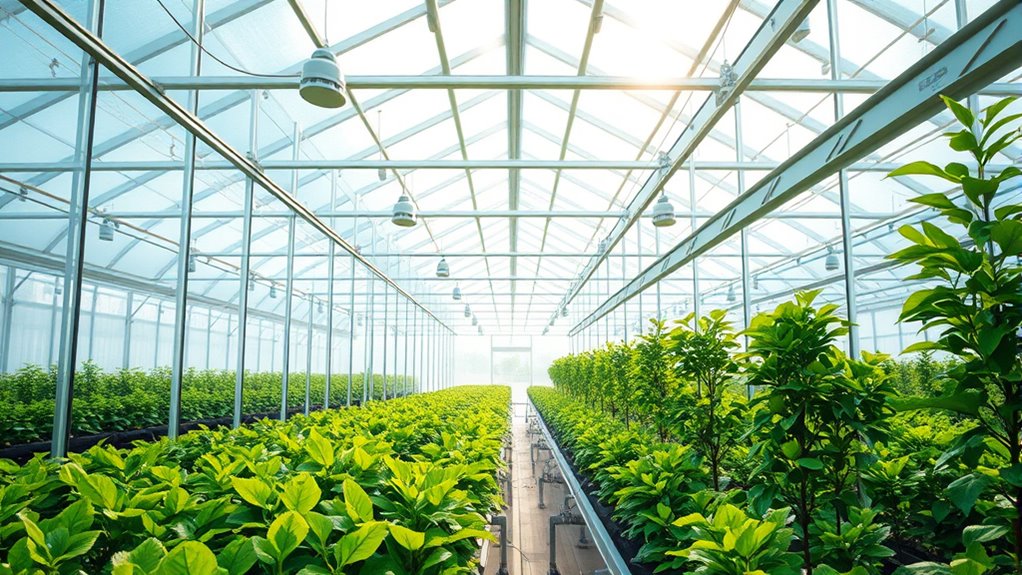
The evolution of greenhouse technology has transformed how we grow crops, making agriculture more efficient and sustainable. Historically, greenhouse development began with simple structures to protect plants from harsh weather, marking a shift from traditional farming methods. Early greenhouses used basic glass and manual ventilation, allowing for better control over growing conditions.
Over time, innovations introduced heating systems, improved insulation, and automated climate regulation, steadily advancing greenhouse capabilities. These developments reduced reliance on unpredictable weather and extended growing seasons. Additionally, the integration of greenhouse sensors and automated systems is now enabling precise management of environmental factors, further enhancing productivity and sustainability. As technology continues to advance, the incorporation of smart climate control systems is expected to further revolutionize controlled environment agriculture.
Key Components of Smart Greenhouses
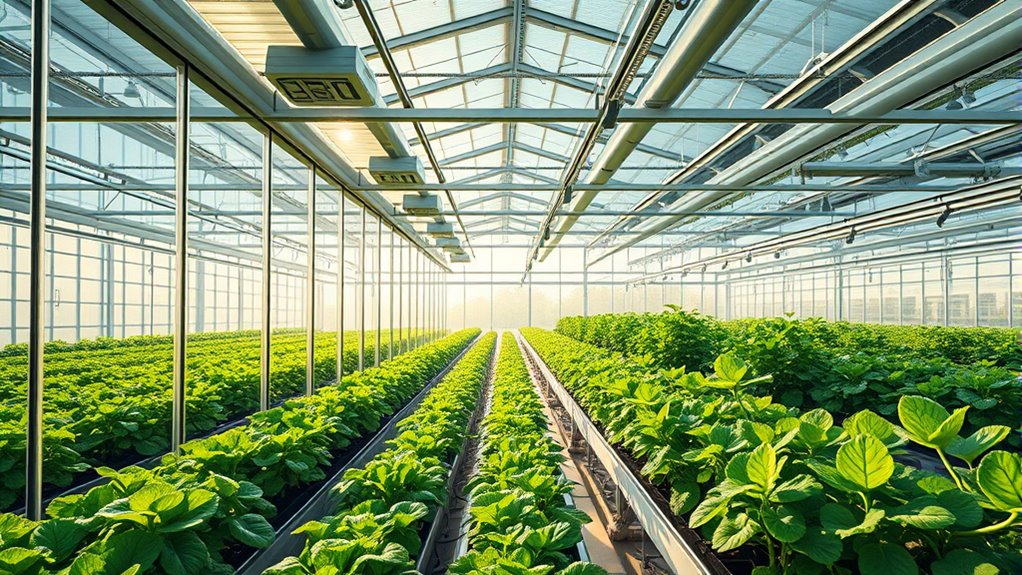
Smart greenhouses rely on a combination of advanced components that work together to create ideal growing conditions. These components guarantee optimal climate control, supporting various crop varieties. Key elements include automated ventilation, heating, and cooling systems that maintain temperature and humidity. Lighting systems, such as LED grow lights, supplement natural sunlight, enhancing photosynthesis. Additionally, irrigation systems deliver precise water and nutrients, promoting healthy growth. Consider the following components:
| Climate Control Systems | Lighting Solutions | Irrigation & Nutrients |
|---|---|---|
| Ventilation fans | LED grow lights | Drip irrigation |
| Heating units | Grow light spectrum | Fertilizer injectors |
| Humidity regulators | Light sensors | Soil moisture sensors |
Moreover, integrating automation technology enables real-time adjustments and improves overall system efficiency. Incorporating AI-driven analytics can further optimize environmental conditions based on data patterns, enhancing crop yields and resource management. Focusing on energy-efficient solutions is also crucial to reduce operational costs and promote sustainability within smart greenhouse operations. These innovations contribute to making controlled environment agriculture more sustainable and productive.
How IoT Sensors Enhance Crop Management

IoT sensors give you real-time data on environmental conditions inside your greenhouse, ensuring ideal growing conditions. With this precise monitoring, you can quickly identify issues and make informed decisions. This data-driven approach helps maximize crop yields and reduce resource waste. High-resolution data from advanced sensors can also facilitate better planning and resource allocation, further enhancing productivity. Additionally, understanding air quality trends can open new opportunities for sustainable food production. Monitoring nutrient levels can help optimize fertilization strategies and improve overall plant health.
Precise Environmental Monitoring
Have you ever wondered how farmers maintain ideal conditions inside greenhouses? Precise environmental monitoring is essential, and IoT sensors make it possible. To guarantee accurate data, regular sensor calibration is crucial, preventing drift that could compromise data accuracy. Maintaining trust in sensor data is vital for reliable crop management. These sensors continuously track temperature, humidity, light, CO₂, and soil moisture, providing real-time insights. This ongoing data collection helps build confidence in the accuracy of environmental readings, which is fundamental for effective decision-making. Incorporating sensor calibration practices ensures sustained measurement precision over time. Proper calibration techniques are supported by advanced digital sound synthesis methods, enhancing the fidelity of sensor outputs. Additionally, leveraging tuning techniques from automotive performance can inspire innovative approaches to sensor optimization, ensuring consistent and reliable data collection. This allows you to:
- Quickly identify environmental fluctuations
- Adjust systems promptly for optimal growth
- Minimize resource waste through precise control
- Detect potential issues before they escalate
- Maintain consistent conditions for healthy crops
Data-Driven Decision Making
By leveraging data collected from environmental sensors, you can make informed decisions that boost crop yield and improve pest management. Real-time insights into soil moisture, temperature, and humidity help you adjust watering and ventilation precisely, preventing stress and supporting healthy growth.
Sensors also detect early signs of pest infestations, enabling prompt intervention before problems escalate. This data-driven approach minimizes resource waste by optimizing fertilizer and water use, reducing costs and environmental impact.
With accurate, timely information, you can fine-tune environmental conditions to maximize productivity while maintaining plant health. Ultimately, utilizing IoT sensor data allows you to create a more efficient, sustainable greenhouse system that consistently delivers higher yields and better pest control.
Artificial Intelligence and Data Analytics in Agriculture

How is artificial intelligence transforming agriculture today? AI and data analytics enable you to optimize crop yield and improve pest management. With AI-driven tools, you can analyze massive amounts of data to make smarter decisions. Here’s how it helps:
AI and data analytics optimize crop yields and enhance pest management through smarter decision-making.
- Predicts ideal planting and harvesting times
- Detects pest infestations early
- Monitors soil health and moisture levels
- Analyzes weather patterns for better planning
- Provides actionable insights to reduce resource waste
- Incorporates precision agriculture techniques to further enhance efficiency
These technologies allow you to fine-tune environmental conditions, improve crop health, and increase productivity. By leveraging AI, you can react quickly to threats like pests and adapt strategies to maximize crop yield. Additionally, advancements in AI-driven data analysis are enabling more accurate forecasting and resource management, making agriculture more sustainable and resilient. Implementing smart greenhouse systems with integrated AI can optimize environmental controls automatically for optimal plant growth. Proper storage and handling of resources, such as juice packaging and storage, are also vital in maintaining crop quality and preventing spoilage. It’s a game-changer for sustainable, efficient agriculture, especially in controlled environments like greenhouses.
Benefits of Automation in Greenhouse Operations
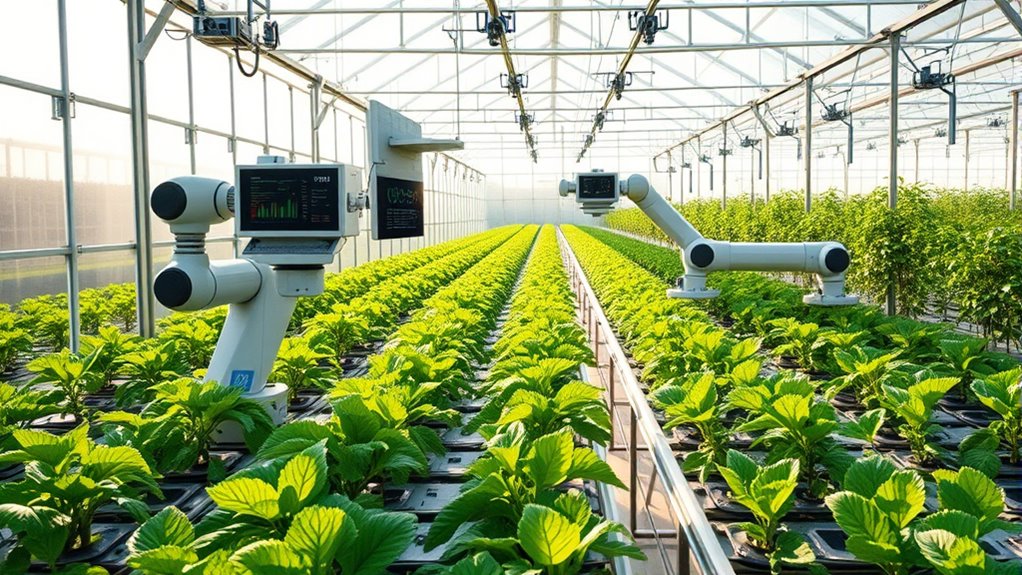
Automation transforms greenhouse operations by streamlining tasks and enhancing precision. With automated watering systems, you guarantee plants receive the right amount of water at the right time, reducing waste and preventing over- or under-watering. This consistency promotes healthier growth and boosts yields.
Climate regulation automation further maximizes conditions by adjusting fans, vents, and shades automatically, maintaining ideal humidity and airflow levels. These systems respond quickly to sensor data, minimizing manual intervention and human error.
As a result, you can focus on other critical aspects of crop management while ensuring superior plant health. Overall, automation increases efficiency, conserves resources, and promotes consistent crop quality, making greenhouse operations more sustainable and profitable.
Environmental Control: Temperature, Humidity, and Light
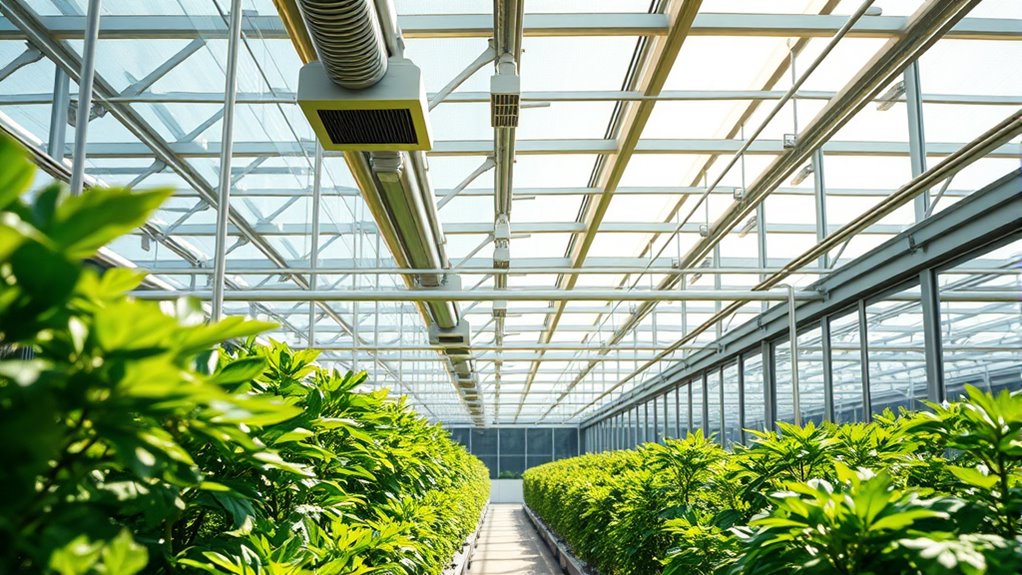
Effective environmental control is key to optimizing greenhouse productivity. By precisely managing temperature, humidity, and light, you can adapt your climate conditions to suit various crops, promoting climate adaptation and boosting crop diversity.
Effective environmental control enhances greenhouse productivity through precise climate management.
This control helps prevent stress and disease, ensuring healthy growth. To achieve this, you should:
- Use sensors to monitor environmental parameters continuously
- Adjust heating, cooling, and ventilation accordingly
- Optimize light exposure with automated shading or supplemental lighting
- Maintain humidity levels to prevent mold and dehydration
- Implement data-driven strategies to fine-tune conditions for different crops
Such practices enable you to create ideal environments for a variety of plants, making your greenhouse more resilient and versatile in changing climates.
This approach maximizes yields and supports sustainable agriculture.
Sustainable Practices and Environmental Impact
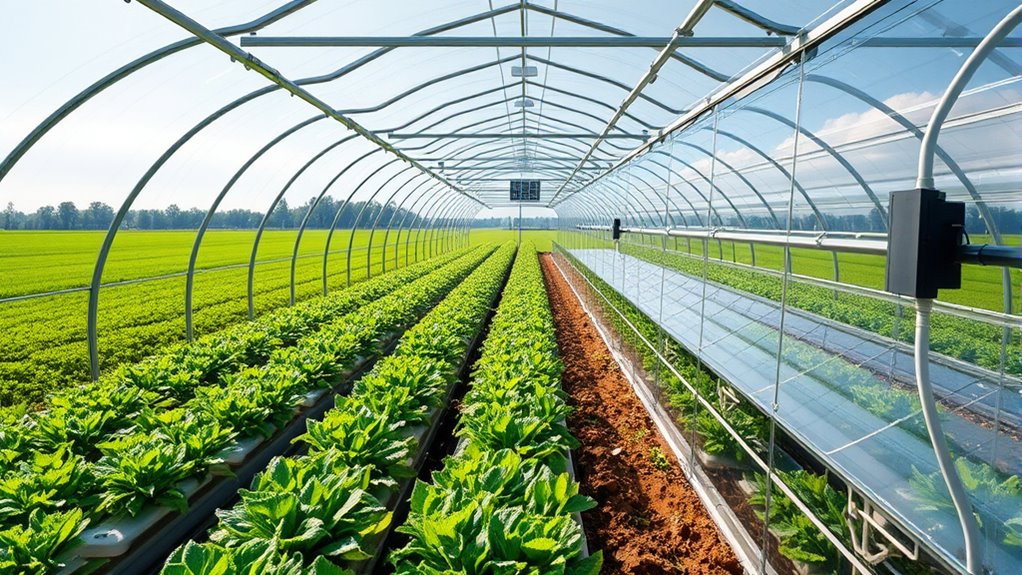
You can improve your greenhouse’s sustainability by adopting resource efficiency strategies like water recycling and energy-saving systems.
These practices help reduce your overall resource consumption and lower operating costs.
Resource Efficiency Strategies
Implementing resource efficiency strategies in greenhouses is essential for sustainable agriculture. You can optimize energy conservation by using LED lighting, automated ventilation, and smart thermostats to reduce power consumption.
Water management is equally crucial; employing drip irrigation, recirculating systems, and soil moisture sensors helps minimize waste.
You should also consider:
- Installing renewable energy sources like solar panels
- Using automated shading systems to control light
- Incorporating rainwater harvesting techniques
- Applying integrated pest management to reduce chemical use
- Optimizing crop layouts for better airflow and light distribution
These practices not only cut costs but also lessen environmental impact, ensuring your greenhouse operates sustainably.
Reducing Carbon Footprint
Reducing the carbon footprint of greenhouses is essential for sustainable agriculture, and adopting environmentally friendly practices can considerably lower greenhouse gas emissions. You can achieve this by prioritizing eco-friendly materials in your greenhouse construction, such as recycled or sustainably sourced options.
Incorporating energy-efficient systems, like LED lighting and advanced insulation, further reduces electricity consumption. Additionally, consider investing in carbon offset programs to neutralize remaining emissions, supporting projects like reforestation or renewable energy.
Implementing sustainable practices not only minimizes your greenhouse’s environmental impact but also enhances its long-term viability. By consciously diminishing emissions and offsetting unavoidable ones, you contribute to a healthier planet while maintaining productive, innovative agriculture.
These steps ensure your greenhouse operates sustainably and responsibly.
Challenges and Limitations of Smart Greenhouses

While smart greenhouses offer promising advancements in agriculture, they also face significant challenges and limitations. Technological barriers can hinder widespread adoption, as integrating complex systems requires specialized skills and reliable infrastructure.
Economic constraints pose another hurdle, with high initial setup costs making it difficult for small-scale farmers to invest. Additionally, ongoing maintenance and energy consumption can be costly, reducing overall profitability.
You may also encounter issues with data security and system reliability, which can compromise operations. Lastly, climate variability and unpredictable weather patterns can still impact even the most advanced systems, limiting their effectiveness in certain regions.
Overcoming these challenges is essential for the broader implementation and success of smart greenhouses in sustainable agriculture.
Future Trends and Innovations in Controlled Environment Agriculture
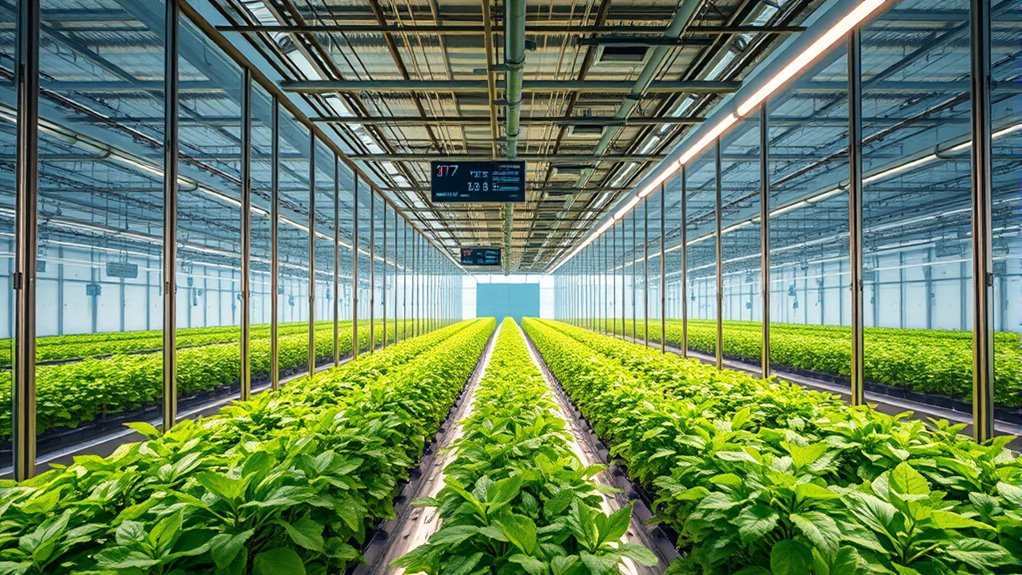
Advancements in controlled environment agriculture are shaping the future of sustainable food production. You’ll see innovations in plant genetics that enable crops to grow faster, resist pests, and withstand climate stresses, making farming more efficient and reliable.
These genetic improvements will expand the variety of crops suited for indoor and greenhouse systems, supporting market expansion into new regions and niches. Automation and AI-driven monitoring will optimize resource use, reducing waste and energy consumption.
Additionally, integration of renewable energy sources will make operations more sustainable. As technology evolves, you’ll find new opportunities to grow fresh produce year-round, regardless of outside weather.
These trends are set to transform agriculture into a more resilient, scalable, and eco-friendly industry, meeting growing global food demands.
Frequently Asked Questions
How Cost-Effective Are Smart Greenhouses for Small-Scale Farmers?
You might wonder if smart greenhouses are cost-effective for small-scale farmers. While the initial investment can be high, you’ll notice significant cost savings over time through reduced water, energy, and labor costs.
Smart technology optimizes resources and minimizes waste, helping you boost yields and profit margins. Although upfront costs are a consideration, the long-term benefits make smart greenhouses a smart choice for sustainable, profitable farming.
What Cybersecurity Risks Are Associated With Iot-Enabled Greenhouses?
You should be aware that IoT-enabled greenhouses face cybersecurity risks like cyber intrusion, which can disrupt your operations. Hackers might target your systems to access sensitive data, risking data privacy breaches.
These vulnerabilities emphasize the importance of robust security measures, such as strong passwords and regular updates. Protecting your greenhouse from cyber threats helps guarantee smooth functioning and safeguards your valuable information from unauthorized access.
How Do Smart Greenhouses Impact Local Biodiversity?
Smart greenhouses can positively impact local biodiversity by creating pollinator habitats and supporting native species preservation.
As you implement these structures, you help maintain native plant populations and attract pollinators like bees and butterflies, which are crucial for ecosystem health.
This encourages a balanced environment, reduces the need for chemical interventions, and promotes coexistence with local wildlife, ultimately strengthening your community’s ecological resilience.
Can Smart Greenhouses Operate Efficiently in Extreme Climates?
You might think extreme climates make farming impossible, but smart greenhouses defy that.
With climate adaptation, they can maintain ideal conditions regardless of outside weather, showcasing impressive energy efficiency.
Ironically, their high-tech systems allow you to grow crops in deserts or Arctic zones, proving that even the harshest environments can become productive.
What Are the Privacy Concerns Related to Data Collection in Smart Greenhouses?
You might worry about data privacy and surveillance concerns when it comes to data collection in smart greenhouses. As sensors and cameras gather information on your operations, there’s a risk that sensitive data could be accessed or misused.
To protect yourself, make certain robust security measures, understand who’s access, and stay informed about data policies. Being proactive helps you maintain control over your data and minimizes privacy risks.
Conclusion
Embrace the future of farming with smart greenhouses that optimize growth, conserve resources, and boost yields. Leverage technology to monitor, control, and adapt your environment effortlessly. Rely on data-driven decisions, automation, and innovative solutions to overcome challenges and open new potentials. With sustainability at the core, these systems revolutionize agriculture—enhancing efficiency, reducing waste, and ensuring food security. Step into this new era where technology and nature work together seamlessly, shaping a smarter, greener tomorrow.
